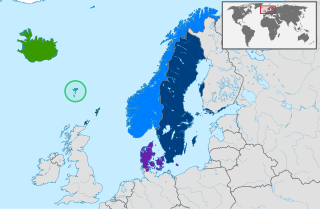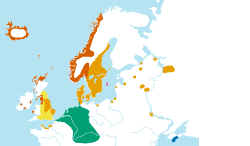
Danish is a North Germanic language from the Indo-European language family spoken by about six million people, principally in and around Denmark. Communities of Danish speakers are also found in Greenland, the Faroe Islands, and the northern German region of Southern Schleswig, where it has minority language status. Minor Danish-speaking communities are also found in Norway, Sweden, the United States, Canada, Brazil, and Argentina.

The Germanic languages are a branch of the Indo-European language family spoken natively by a population of about 515 million people mainly in Europe, North America, Oceania, and Southern Africa. The most widely spoken Germanic language, English, is also the world's most widely spoken language with an estimated 2 billion speakers. All Germanic languages are derived from Proto-Germanic, spoken in Iron Age Scandinavia, Iron Age Northern Germany and along the North Sea and Baltic coasts.

Old Norse, also referred to as Old Nordic, or Old Scandinavian, was a stage of development of North Germanic dialects before their final divergence into separate Nordic languages. Old Norse was spoken by inhabitants of Scandinavia and their overseas settlements and chronologically coincides with the Viking Age, the Christianization of Scandinavia, and the consolidation of Scandinavian kingdoms from about the 8th to the 15th centuries.

The North Germanic languages make up one of the three branches of the Germanic languages—a sub-family of the Indo-European languages—along with the West Germanic languages and the extinct East Germanic languages. The language group is also referred to as the Nordic languages, a direct translation of the most common term used among Danish, Faroese, Icelandic, Norwegian, and Swedish scholars and people.
The Danish and Norwegian alphabet is the set of symbols, forming a variant of the Latin alphabet, used for writing the Danish and Norwegian languages. It has consisted of the following 29 letters since 1917 (Norwegian) and 1948 (Danish):

Rasmus Kristian Rask was a Danish linguist and philologist. He wrote several grammars and worked on comparative phonology and morphology. Rask traveled extensively to study languages, first to Iceland, where he wrote the first grammar of Icelandic, and later to Russia, Persia, India, and Ceylon. Shortly before his death, he was hired as professor of Eastern languages at the University of Copenhagen. Rask is especially known for his contributions to comparative linguistics, including an early formulation of what would later be known as Grimm's Law. He was elected as a member to the American Philosophical Society in 1829.

Scanian is an East Scandinavian dialect spoken in the province of Scania in southern Sweden.

A rune is a letter in a set of related alphabets known as runic alphabets native to the Germanic peoples. Runes were used to write Germanic languages before they adopted the Latin alphabet, and for specialised purposes thereafter. In addition to representing a sound value, runes can be used to represent the concepts after which they are named (ideographs). Scholars refer to instances of the latter as Begriffsrunen. The Scandinavian variants are also known as fuþark, or futhark; this name is derived from the first six letters of the script, ⟨ᚠ⟩, ⟨ᚢ⟩, ⟨ᚦ⟩, ⟨ᚨ⟩/⟨ᚬ⟩, ⟨ᚱ⟩, and ⟨ᚲ⟩/⟨ᚴ⟩, corresponding to the Latin letters ⟨f⟩, ⟨u⟩, ⟨þ⟩/⟨th⟩, ⟨a⟩, ⟨r⟩, and ⟨k⟩. The Anglo-Saxon variant is known as futhorc, or fuþorc, due to changes in Old English of the sounds represented by the fourth letter, ⟨ᚨ⟩/⟨ᚩ⟩.
The Younger Futhark, also called Scandinavian runes, is a runic alphabet and a reduced form of the Elder Futhark, with only 16 characters, in use from about the 9th century, after a "transitional period" during the 7th and 8th centuries. The reduction, somewhat paradoxically, happened at the same time as phonetic changes that led to a greater number of different phonemes in the spoken language, when Proto-Norse evolved into Old Norse. Also, the writing custom avoided carving the same rune consecutively for the same sound, so the spoken distinction between long and short vowels was lost in writing. Thus, the language included distinct sounds and minimal pairs that were written the same.
Jutlandic, or Jutish, is the western variety of Danish, spoken on the peninsula of Jutland in Denmark.
Proto-Norse was an Indo-European language spoken in Scandinavia that is thought to have evolved as a northern dialect of Proto-Germanic in the first centuries CE. It is the earliest stage of a characteristically North Germanic language, and the language attested in the oldest Scandinavian Elder Futhark inscriptions, spoken from around the 2nd to the 8th centuries CE. It evolved into the dialects of Old Norse at the beginning of the Viking Age around 800 CE, which later themselves evolved into the modern North Germanic languages.
Old Swedish is the name for two distinct stages of the Swedish language that were spoken in the Middle Ages: Early Old Swedish, spoken from about 1225 until about 1375, and Late Old Swedish, spoken from about 1375 until about 1526.
Stød is a suprasegmental unit of Danish phonology, which in its most common form is a kind of creaky voice (laryngealization), but it may also be realized as a glottal stop, especially in emphatic pronunciation. Some dialects of Southern Danish realize stød in a way that is more similar to the tonal word accents of Norwegian and Swedish. In much of Zealand it is regularly realized as reminiscent of a glottal stop. A probably unrelated glottal stop, with quite different distribution rules, occurs in Western Jutland and is known as the vestjysk stød. The noun stød itself does not have a stød.
In the 9th century, Old Norse began to diverge into Old West Norse and Old East Norse. In the 12th century, the dialects of Denmark and Sweden began to diverge, becoming Old Danish and Old Swedish in the 13th century. All were heavily influenced by Middle Low German during the medieval period. Though stages of language development are never as sharply delimited as implied here, and should not be taken too literally, the system of subdivisions used in this article is the most commonly used by Swedish linguists and is used for the sake of practicality.
Bornholmsk is an East Danish dialect spoken on the island of Bornholm in the Baltic Sea. It was originally part of the East Danish dialect continuum, which includes the dialects of southern Sweden, but became isolated in the Danish dialect landscape after 1658, when Sweden annexed the eastern Danish provinces of Scania (Skåne), Halland and Blekinge.

The Danish language has a number of regional and local dialect varieties. These can be divided into the traditional dialects, which differ from modern Standard Danish in both phonology and grammar, and the Danish accents, which are local varieties of the standard language distinguished mostly by pronunciation and local vocabulary colored by traditional dialects. Traditional dialects are now mostly extinct in Denmark, with only the oldest generations still speaking them.

Félag was a joint financial venture between partners in Viking Age society.
The phonology of Danish is similar to that of the other closely related Scandinavian languages, Swedish and Norwegian, but it also has distinct features setting it apart. For example, Danish has a suprasegmental feature known as stød which is a kind of laryngeal phonation that is used phonemically. It also exhibits extensive lenition of plosives, which is noticeably more common than in the neighboring languages. Because of these and a few other features, spoken Danish can be challenging for Norwegians and Swedes to understand without training, although they can easily read written Danish.
Danish orthography is the system and norms used for writing the Danish language, including spelling and punctuation.
Elisabeth (Lis) Jacobsen, née Rubin, was a Danish philologist, archaeologist and writer. She is remembered first and foremost for her research and publications on the history of the Danish language. Among other books, she also published a comprehensive analysis of all known runic inscriptions in Denmark. From 1911, Jacobsen played a major role in all fields of research related to the Danish language.











